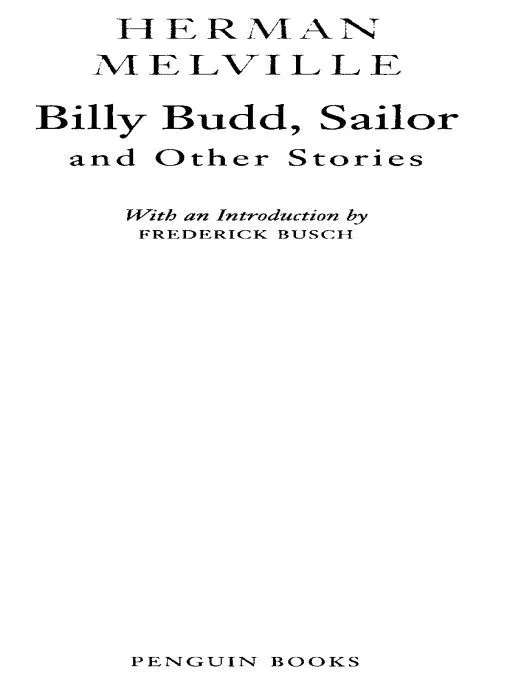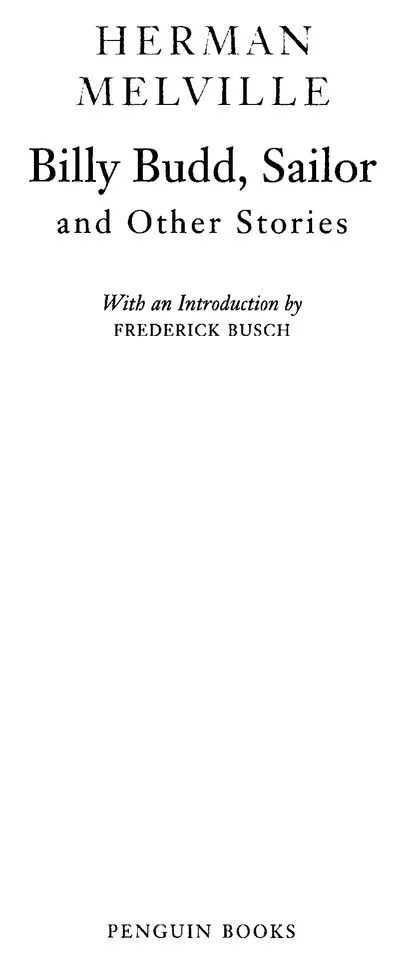Billy Budd and Other Stories

Table of Contents
Title Page
Copyright Page
Introduction
Bartleby
The Piazza
The Encantadas or Enchanted Isles
The Bell-Tower
Benito Cereno
The Paradise Of Bachelors And The Tartarus of Maids
Billy Budd, Sailor - (An inside narrative)
FOR THE BEST IN PAPERBACKS, LOOK FOR THE
CLICK ON A CLASSIC
Read more Herman Melville in Penguin Classics
FOR THE BEST IN CLASSIC LITERATURE LOOK FOR THE
PENGUIN CLASSICS
CLASSICS
BILLY BUDD, SAILOR AND OTHER STORIES
HERMAN MELVILLE was born on August 1, 1819, in New York City, the son of a merchant. Only twelve when his father died bankrupt, young Herman tried work as a bank clerk, as a cabin-boy on a trip to Liverpool, and as an elementary schoolteacher, before shipping in January 1841 on the whaler Acushnet, bound for the Pacific. Deserting ship the following year in the Marquesas, he made his way to Tahiti and Honolulu, returning as ordinary seaman on the frigate United States to Boston, where he was discharged in October 1844. Books based on these adventures won him immediate success. By 1850 he was married, had acquired a farm near Pittsfield, Massachusetts (where he was the impetuous friend and neighbor of Nathaniel Hawthorne), and was hard at work on his masterpiece Moby-Dick. But literary success soon faded; his complexity increasingly alienated readers. After a visit to the Holy Land in January 1857, he turned from writing prose fiction to poetry. In 1863, during the Civil War, he moved back to New York City, where from 1866 to 1885 he was a deputy inspector in the Custom House, and where, on September 28, 1891, he died. A draft of a final prose work, Billy Budd, Sailor, was left unfinished and uncollated; packed tidily away by his widow, it was not rediscovered and published until 1924.
FREDERICK BUSCH is the author of many works of fiction, including the novels Rounds, Take This Man, The Mutual Friend, and Invisible Writing. He teaches literature and fiction writing at Colgate University.

BookishMall.com
Published by the Penguin Group
Penguin Group (USA) Inc., 375 Hudson Street, New York, New York 10014, U.S.A.
Penguin Group (Canada), 90 Eglinton Avenue East, Suite 700, Toronto, Ontario,
Canada M4P 2Y3 (a division of Pearson Penguin Canada Inc.)
Penguin Books Ltd, 80 Strand, London WC2R ORL, England
Penguin Ireland, 25 St Stephen’s Green, Dublin 2, Ireland (a division of Penguin Books Ltd)
Penguin Group (Australia), 250 Camberwell Road, Camberwell, Victoria 3124, Australia (a division of Pearson Australia Group Pty Ltd)
Penguin Books India Pvt Ltd, 11 Community Centre, Panchsheel Park,
New Delhi - -110 017, India
Penguin Group (NZ), 67 Apollo Drive, Rosedale, North Shore 0632,
New Zealand (a division of Pearson New Zealand Ltd)
Penguin Books (South Africa) (Pty) Ltd, 24 Sturdee Avenue, Rosebank,
Johannesburg 2196, South Africa
Penguin Books Ltd, Registered Offices: 80 Strand, London WC2R ORL, England
This edition edited and with an introduction by Frederick Busch first published in the United States of America in Penguin Classics, 1986 Simultaneously published in Canada
Introduction copyright © Viking Penguin Inc., 1986
All rights reserved
Billy Budd, Sailor (An inside narrative) is the Reading Text as edited from
a genetic study of the manuscript by Harrison Hayford and Merton M.
Sealts, Jr., here
eISBN : 978-1-101-07586-9
The scanning, uploading and distribution of this book via the Internet or via any
other means without the permission of the publisher is illegal and punishable by
law. Please purchase only authorized electronic editions, and do not participate
in or encourage electronic piracy of copyrighted materials. Your support of
the author’s rights is appreciated.
http://us.penguingroup.com
Introduction
When he was thirty-three he felt finished. The book he knew to be speciat—it “is of the horrible texture of a fabric that should be woven of ships’ cables & hawsers,” he wrote. “A Polar wind blows through it, & birds of prey hover over it”—had failed. American and English reviewers had roasted Moby-Dick (1851), and in eighteen months the American edition sold 2,300 copies. Pierre (1852) sold 2,030 copies over thirty-five years, earning Melville the scorn of reviewers—they questioned his sanity as well as his skill—and, by the end of his life, a total of $157.
He had to worry about money, for he farmed a little but counted on the harvest of his writing, and his wife’s small trust fund, for the support of their family. This support was threatened, and since money is a letter from the world to an author about his work, Melville had to face up to the prospect of not getting across his doubting dark vision; for he received too little of the mail that would have assured him that he was heard. As he had complained in a letter to Hawthorne in 1851: “Dollars damn me; and the malicious Devil is forever grinning in upon me, holding the door ajar.... I shall be worn out and perish, like an old nutmeg grater, grated to pieces by the constant attrition of the wood, that is, the nutmeg. What I feel most moved to write, that is banned—it will not pay. Yet, altogether, write the otber way I cannot. So the product is a final hash, and all my books are botches.”
The well-received author of travel and adventure stories such as Typee (1846) and Mardi (1849) had become the student of Shakespeare’s and Carlyle’s works, the hard questioner of heavenly works, and the man whose soul had resonated in response to the works of Nathaniel Hawthorne—“there is the blackness of darkness beyond,” he wrote of Hawthorne’s tales, and he praised “those short, quick probings at the very axis of reality,” which had “dropped germinous seeds into my soul.” Melville had lost what ease he’d possessed, and now his work, too, would lose its ease. Into Moby-Dick, which he was writing as he wrote to Hawthorne, he put “the sane madness of vital truth,” and the world didn’t want to hear it.
And so we come to the exhausted Melville of 1852. He begins to speak—it is nearly impossible, still, for him to be silent—of what obsesses him: the failure of crucial messages to get through. That matter becomes central; those messages are the mail of which I speak.
It is likely that Melville had come to love Hawthorne: the handsome older writer, Melville wrote in “Hawthorne and His Mosses” in 1850, “shoots his strong... roots into the hot soil of my ... soul.” They were neighbors and saw one another, though less than Melville wished, and then Hawthorne moved away; they corresponded, exchanging books (Pierre for The Blithedale Romance) and ideas. The case of Agatha Hatch Robertson was relayed by Melville. It involved a young wife who waited seventeen years for word—literally, for mail—from her husband, who had left to seek work. Melville here postulates to Hawthorne how the story of Agatha and her mailbox might be told: “As her hopes gradually decay in her, so does the post itself & the little box decay. The post rots in the ground at last. Owing to its being little used— hardly used at all—grass grows rankly about it.
1 comment